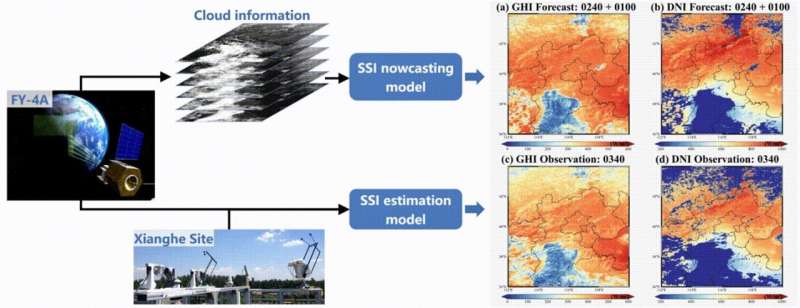Scientists develop a solar energy nowcasting system based on Fengyun-4 satellite

Solar energy generation depends on weather conditions, and energy input experiences strong and frequent fluctuations. Surface solar irradiance nowcasting (0–3 h) is an effective way to overcome the intermittency of solar energy and to ensure the safe operation of grid-connected solar power plants.
Using the existing Fengyun-4A satellite and its abundant weather data, scientists from the Institute of Atmospheric Physics (IAP) of the Chinese Academy of Sciences (CAS), Harbin Institute of Technology (HIT) and National Satellite Meteorological Center (NSMC) created a nowcasting system for surface solar irradiance.
Their study was published in Advances in Atmospheric Sciences on June 23.
Fengyun-4A (FY-4A), part of the newest generation of Chinese geostationary satellites, provides a new measurement for solar energy monitoring with high resolution.
The proposed system is composed of two key components: The first part is a hybrid surface solar irradiance estimation method combining a physical clear-sky model and an empirical cloudy-sky model; the second part is the surface solar irradiance nowcasting model deriving the cloud motion vector using the block-matching method. These two components allow the system to provide solar energy forecasts, under different sky conditions, within a 3-hour lead time.
To further investigate the system's accuracy and applicability, the researchers evaluated its performance under different sky conditions observed in the North China region.
They found that the spatiotemporal distribution of surface solar irradiance forecasts was very close to ground observations. The discrepancy of surface solar irradiance estimates depended on cloud occurrence frequency, and there was an apparent seasonal pattern.
The data from FY-4A along with this new nowcasting system has great potential to promote photovoltaic energy systems development and to reduce carbon emissions across China.
For the next step, the researchers will improve the applicability of the surface solar irradiance estimation model considering different regions and seasons in China, as well as the formation and dissipation process of clouds.
More information: Chunlin Huang et al, Fengyun-4 Geostationary Satellite-Based Solar Energy Nowcasting System and Its Application in North China, Advances in Atmospheric Sciences (2022). DOI: 10.1007/s00376-022-1464-0
Journal information: Advances in Atmospheric Sciences
Provided by Chinese Academy of Sciences




















